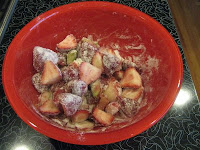
I am practicing for an Asian-themed dinner party coming up in June. As an appetizer, I wanted to serve a recipe I saw in Vegetarian Times for Spicy Broccoli Sprout Sushi. A variety of sprouts could be used but this recipe called for the peppery broccoli sprout.
- 1 cup sushi rice, rinsed and drained (I found it in the bulk foods section of Whole Foods)
- 1 cup water
- Nori sheets
- Avocado, sliced
- Red bell pepper, thinly sliced
- Baked tofu (I used teriyaki flavored), cut into thin strips
- Broccoli sprouts (Safeway)
- Soy sauce and wasabi for dipping
- Place rinsed and drained sushi rice in a saucepan with the water. Bring to a boil. Cover, reduce heat to low and simmer until the water is absorbed.
- Remove rice from heat and let cool for about 20 minutes.
- Stir in rice vinegar
- Lay a nori sheet on a sushi mat. Have a bowl of water and a towel close by.
- Spread rice over the nori sheet. With moistened fingers press the rice down. Cover the sheet with rice but leave about an inch and a half at the top uncovered.
- Lay a few slices of avocado, bell pepper, and tofu across the center. Cover with sprouts
- Brush edges of nori with water.
- Tightly roll nori until just the uncovered top is showing. Moisten with wet fingers and complete roll.
- Slice and serve with wasabi and soy sauce.

You can search YouTube for sushi rolling directions.





